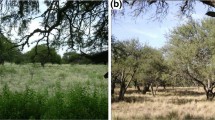Abstract
Euphrasia stricta var.suecica, E. stricta var.tenuis, andRhinanthus serotinus subsp.vernalis are three endangered, hemiparasitic annual herbs found in traditionally managed hay meadows on Gotland, Sweden. We have studied — experimentally and in the field — how some features in the present and traditional management cycle affect their fitness.
We set up permanent 50 × 50-cm plots in a coastal hay meadow where bothE. stricta var.suecica andRhinanthus are still quite common. The survival, growth and fecundity of cohorts ofEuphrasia andRhinanthus were followed throughout the growing season for three years. The length of the growing season was vital forEuphrasia andRhinanthus performance. In cooler summers, the percentage ofEuphrasia individuals that produced mature seeds was decreased by 20% at the time of mowing. This indicates the need to individually adjust the time of mowing, as was formerly done, to the actual phenological development in order to maintain healthy populations. It is also important to consider the effect of time of mowing on total species richness, asEuphrasia more successfully established in 10 × 10-cm squares with high species richness.
Also, the time in spring when hemiparasite growth started was crucial. Cohorts of bothEuphrasia stricta var.suecica andRhinanthus that connected to hosts and started growing early in the season had a strong advantage over later cohorts by having fitness values four to eight times higher. From this we conclude that the traditional practice of spring raking is important for the long-term persistence of these hemiparasites, since raking promotes an earlier onset of both host and hemiparasite growth.
Another important issue is the traditional, but nowadays often neglected practice of letting the hay dry in the meadow after mowing. Hay that was left to dry in the meadow contributed significantly moreRhinanthus seed to the meadow than hay that was taken away immediately after mowing.
We also found that seedling emergence and subsequent growth ofEuphrasia stricta var.suecica was greatly enhanced by a second hay cut in September. A second cutting mimics some of the positive effects of the traditional practice of aftermath grazing, which is nowadays often abandoned.
Similar content being viewed by others
References
Berlin G.A.I., Linusson A.-C. &Olsson E.G.A. (2000): Vegetation changes in semi-natural meadows with unchanged management in southern Sweden, 1965–1990.Acta Oecol. 21: 125–138.
Bullock J.M., Clear Hill B., Dale M.P. &Silvertown J. (1994): An experimental study of vegetation change due to sheep grazing in a species-poor grassland and the role of seedling recruitment into gaps.J. Appl. Ecol. 31: 493–507.
Coulson S.J., Bullock J.B., Stevenson M.J. &Pywell R.F. (2001): Colonization of grassland by sown species: dispersal versus microsite limitation in responses to management.J. Appl. Ecol. 38: 204–216.
Davies D.M., Graves J.D., Elias C.O. &Williams P.J. (1997): The impact ofRhinanthus spp. on sward productivity and composition: implications for the restoration of species-rich grasslands.Biol. Conservation 82: 87–93.
Deevey E.S., Jr. (1947): Life tables for natural populations of animals.Quart. Rev. Biol. 22: 283–314.
Ebert T.A. (1999):Plant and animal populations. Methods in demography. Academic Press, San Diego.
Ekstam U., Aronsson M. &Forshed N. (1988):Ängar. Om naturliga slåttermarker i odlingslandskapet (Haymeaclows in the cultural landscape). LTs förlag, Stockholm.
Fritsch F.E. &Salisbury E. (1946):Plant form and function. Bell & Sons, London.
Gibson C.C. &Watkinson A.R. (1992): The role of the hemiparasitic annualRhinanthus minor in determining grassland community structure.Oecologia 89: 62–68.
Hellström K., Rautio P., Huhta A.-P. &Tuomi J. (2004): Tolerance of an annual hemiparasite,Euphrasia stricta agg., to simulated grazing in relation to the host environment.Flora 199: 247–255.
Jonsell B. &Karlsson T. (2004): Endemic vascular plants in Norden. In:Jonsell B. (ed.),Flora Nordica. General volume, Bergius Foundation, Royal Swedish Academy of Sciences, Stockholm, pp. 139–159.
Jensen K. (2004): Dormancy patterns, germination ecology, and seed-bank types of twenty fen grassland species.Wetlands 24: 152–166.
Karlsson T. (1982):Euphrasia rostkoviana in Sweden.Växtekol. Stud. 15: 1–116.
Karlsson T. (1984): Early-flowering taxa ofEuphrasia (Scrophulariaceae) on Gotland, Sweden.Nord. J. Bot. 4: 303–326.
Karlsson T. (1998): Förteckning över svenska kärlväxter (The vascular plants of Sweden — a checklist).Svensk Bot. Tidskr. 91: 241–560.
Kolseth A.-K. (2004): Euphrasia strictaon Gotland — phylogeography and conservation. Licentiate thesis, Dept. of Plant Ecology, Uppsala University, Uppsala.
Kuijt J. (1969):The biology of parasitic flowering plants. University of California Press, Berkeley.
Linusson A.-C., Berlin G.A.I. &Olsson E.G.A. (1998): Reduced community diversity in semi-natural meadows in southern Sweden, 1965–1990.Pl. Ecol. 136: 77–94.
Press M.C. (1989): Autotrophy and heterotrophy in root hemiparasites.Trends Ecol. Evol. 4: 258–263.
Seel W.E. &Press M.C. (1993): Influence of the host on three Sub-Arctic facultative hemiparasites. I. Growth, mineral accumulation and above ground dry-matter partitioning.New Phytol. 125: 131–138.
SMHI (2003):Väder och vatten, nr 13 (Weather and water, nr 13). Sveriges meteorologiska och hydrologiska institut, Norrköping.
Svensson B.M. &Carlsson B.Å. (2004): Significance of time of attachment, host type, and neighbouring hemiparasites in determining fitness in two endangered grassland hemiparasites.Ann. Bot. Fenn. 41: 63–75.
Svensson B.M., Seel W.E., Nilsson C.H. &Carlsson B.Å. (2001): Roles played by timing of seedling development and host identity in determining fitness of an annual, subarctic, hemiparasitic plant.Arct. Antarct. Alp. Res. 33: 299–305.
ter Borg S.J. (1972):Variability of Rhinanthus serotinus (Schönh.)Oborny in relation to the environment. Ph.D. Thesis, University of Groningen, Groningen.
ter Borg S.J. (1985): Population biology and habitat relations of some hemiparasiticScrophulariaceae. In: White J. (ed.),The population structure of vegetation, Dr. W. Junk Publishers, Dordrecht, pp. 463–487.
van Hulst R., Shipley B. &Theriault A. (1987): Why isRhinanthus minor such a good invader?Canad. J. Bot. 65: 2373–2379.
Watkinson A.R. &Gibson C.C. (1988): Plant parasitism: the population dynamics of parasitic plants and their effects upon plant community structure. In:Davy A.J., Hutchings M.J. &Watkinson A.R. (eds),Plant population biology, Blackwell, Oxford, pp. 393–412.
Zar J.H. (1999):Biostatistical analysis. Prentice Hall, Upper Saddle River.
Author information
Authors and Affiliations
Corresponding author
Rights and permissions
About this article
Cite this article
Svensson, B.M., Carlsson, B.Å. How can we protect rare hemiparasitic plants? Early-flowering taxa ofEuphrasia andRhinanthus on the Baltic island of Gotland. Folia Geobot 40, 261–272 (2005). https://doi.org/10.1007/BF02803239
Received:
Revised:
Accepted:
Issue Date:
DOI: https://doi.org/10.1007/BF02803239
Keywords
- Cohort
- Euphrasia stricta var.suecica
- Euphrasia stricta var.tenuis
- Fitness
- Rhinanthus serotinus subsp.vernalis
- Semi-natural grasslands
- Wooded hay meadow




